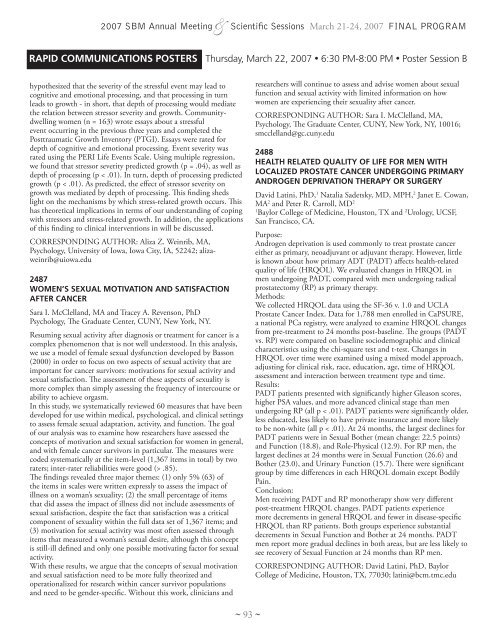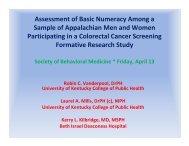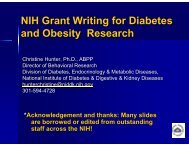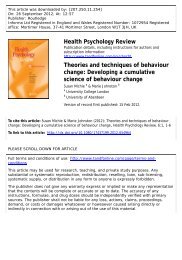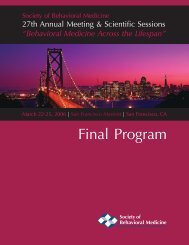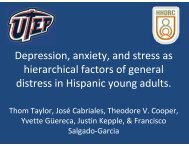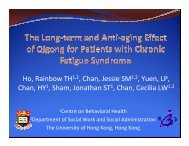2007 Final Program - Society of Behavioral Medicine
2007 Final Program - Society of Behavioral Medicine
2007 Final Program - Society of Behavioral Medicine
Create successful ePaper yourself
Turn your PDF publications into a flip-book with our unique Google optimized e-Paper software.
<strong>2007</strong> SBM Annual Meeting & Scientific Sessions March 21-24, <strong>2007</strong> FINAL PROGRAM<br />
Rapid Communications Posters Thursday, March 22, <strong>2007</strong> • 6:30 PM-8:00 PM • Poster Session B<br />
hypothesized that the severity <strong>of</strong> the stressful event may lead to<br />
cognitive and emotional processing, and that processing in turn<br />
leads to growth - in short, that depth <strong>of</strong> processing would mediate<br />
the relation between stressor severity and growth. Communitydwelling<br />
women (n = 163) wrote essays about a stressful<br />
event occurring in the previous three years and completed the<br />
Posttraumatic Growth Inventory (PTGI). Essays were rated for<br />
depth <strong>of</strong> cognitive and emotional processing. Event severity was<br />
rated using the PERI Life Events Scale. Using multiple regression,<br />
we found that stressor severity predicted growth (p = .04), as well as<br />
depth <strong>of</strong> processing (p < .01). In turn, depth <strong>of</strong> processing predicted<br />
growth (p < .01). As predicted, the effect <strong>of</strong> stressor severity on<br />
growth was mediated by depth <strong>of</strong> processing. This finding sheds<br />
light on the mechanisms by which stress-related growth occurs. This<br />
has theoretical implications in terms <strong>of</strong> our understanding <strong>of</strong> coping<br />
with stressors and stress-related growth. In addition, the applications<br />
<strong>of</strong> this finding to clinical interventions in will be discussed.<br />
CORRESPONDING AUTHOR: Aliza Z. Weinrib, MA,<br />
Psychology, University <strong>of</strong> Iowa, Iowa City, IA, 52242; alizaweinrib@uiowa.edu<br />
2487<br />
WOMEN’S SEXUAL MOTIVATION AND SATISFACTION<br />
AFTER CANCER<br />
Sara I. McClelland, MA and Tracey A. Revenson, PhD<br />
Psychology, The Graduate Center, CUNY, New York, NY.<br />
Resuming sexual activity after diagnosis or treatment for cancer is a<br />
complex phenomenon that is not well understood. In this analysis,<br />
we use a model <strong>of</strong> female sexual dysfunction developed by Basson<br />
(2000) in order to focus on two aspects <strong>of</strong> sexual activity that are<br />
important for cancer survivors: motivations for sexual activity and<br />
sexual satisfaction. The assessment <strong>of</strong> these aspects <strong>of</strong> sexuality is<br />
more complex than simply assessing the frequency <strong>of</strong> intercourse or<br />
ability to achieve orgasm.<br />
In this study, we systematically reviewed 60 measures that have been<br />
developed for use within medical, psychological, and clinical settings<br />
to assess female sexual adaptation, activity, and function. The goal<br />
<strong>of</strong> our analysis was to examine how researchers have assessed the<br />
concepts <strong>of</strong> motivation and sexual satisfaction for women in general,<br />
and with female cancer survivors in particular. The measures were<br />
coded systematically at the item-level (1,367 items in total) by two<br />
raters; inter-rater reliabilities were good (> .85).<br />
The findings revealed three major themes: (1) only 5% (63) <strong>of</strong><br />
the items in scales were written expressly to assess the impact <strong>of</strong><br />
illness on a woman’s sexuality; (2) the small percentage <strong>of</strong> items<br />
that did assess the impact <strong>of</strong> illness did not include assessments <strong>of</strong><br />
sexual satisfaction, despite the fact that satisfaction was a critical<br />
component <strong>of</strong> sexuality within the full data set <strong>of</strong> 1,367 items; and<br />
(3) motivation for sexual activity was most <strong>of</strong>ten assessed through<br />
items that measured a woman’s sexual desire, although this concept<br />
is still-ill defined and only one possible motivating factor for sexual<br />
activity.<br />
With these results, we argue that the concepts <strong>of</strong> sexual motivation<br />
and sexual satisfaction need to be more fully theorized and<br />
operationalized for research within cancer survivor populations<br />
and need to be gender-specific. Without this work, clinicians and<br />
researchers will continue to assess and advise women about sexual<br />
function and sexual activity with limited information on how<br />
women are experiencing their sexuality after cancer.<br />
CORRESPONDING AUTHOR: Sara I. McClelland, MA,<br />
Psychology, The Graduate Center, CUNY, New York, NY, 10016;<br />
smcclelland@gc.cuny.edu<br />
2488<br />
HEALTH RELATED QUALITY OF LIFE FOR MEN WITH<br />
LOCALIZED PROSTATE CANCER UNDERGOING PRIMARY<br />
ANDROGEN DEPRIVATION THERAPY OR SURGERY<br />
David Latini, PhD, 1 Natalia Sadetsky, MD, MPH, 2 Janet E. Cowan,<br />
MA 2 and Peter R. Carroll, MD 2<br />
1<br />
Baylor College <strong>of</strong> <strong>Medicine</strong>, Houston, TX and 2 Urology, UCSF,<br />
San Francisco, CA.<br />
Purpose:<br />
Androgen deprivation is used commonly to treat prostate cancer<br />
either as primary, neoadjuvant or adjuvant therapy. However, little<br />
is known about how primary ADT (PADT) affects health-related<br />
quality <strong>of</strong> life (HRQOL). We evaluated changes in HRQOL in<br />
men undergoing PADT, compared with men undergoing radical<br />
prostatectomy (RP) as primary therapy.<br />
Methods:<br />
We collected HRQOL data using the SF-36 v. 1.0 and UCLA<br />
Prostate Cancer Index. Data for 1,788 men enrolled in CaPSURE,<br />
a national PCa registry, were analyzed to examine HRQOL changes<br />
from pre-treatment to 24 months post-baseline. The groups (PADT<br />
vs. RP) were compared on baseline sociodemographic and clinical<br />
characteristics using the chi-square test and t-test. Changes in<br />
HRQOL over time were examined using a mixed model approach,<br />
adjusting for clinical risk, race, education, age, time <strong>of</strong> HRQOL<br />
assessment and interaction between treatment type and time.<br />
Results:<br />
PADT patients presented with significantly higher Gleason scores,<br />
higher PSA values, and more advanced clinical stage than men<br />
undergoing RP (all p < .01). PADT patients were significantly older,<br />
less educated, less likely to have private insurance and more likely<br />
to be non-white (all p < .01). At 24 months, the largest declines for<br />
PADT patients were in Sexual Bother (mean change: 22.5 points)<br />
and Function (18.8), and Role-Physical (12.9). For RP men, the<br />
largest declines at 24 months were in Sexual Function (26.6) and<br />
Bother (23.0), and Urinary Function (15.7). There were significant<br />
group by time differences in each HRQOL domain except Bodily<br />
Pain.<br />
Conclusion:<br />
Men receiving PADT and RP monotherapy show very different<br />
post-treatment HRQOL changes. PADT patients experience<br />
more decrements in general HRQOL and fewer in disease-specific<br />
HRQOL than RP patients. Both groups experience substantial<br />
decrements in Sexual Function and Bother at 24 months. PADT<br />
men report more gradual declines in both areas, but are less likely to<br />
see recovery <strong>of</strong> Sexual Function at 24 months than RP men.<br />
CORRESPONDING AUTHOR: David Latini, PhD, Baylor<br />
College <strong>of</strong> <strong>Medicine</strong>, Houston, TX, 77030; latini@bcm.tmc.edu<br />
~ 93 ~


